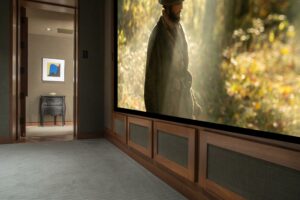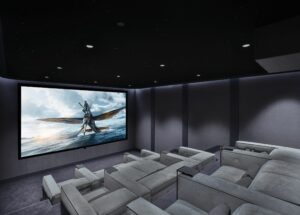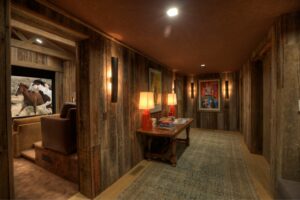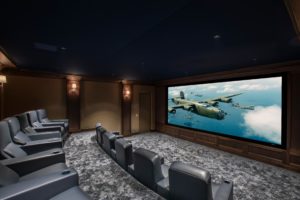The Minema, A Cinema Story
The origin of any cinema story may differ, depending on who is asking and who is telling. In fact, there may be many beginnings from an owner’s point of view as the owner of The Minema points out. “This was a convergence of several long-term interests,” he muses. “I have always loved music. The very first job I had when I was working as a high school student, with that money, I bought my first stereo. And, I’ve always loved movies, not to mention gadgets and technology.” From the couple’s perspective, the story begins in their previous home. “There was a small den and I said, why don’t we turn this into a little screening room?” Further explaining, “it was a prototype. It was not ideal circumstances, but it did introduce me to acoustic treatment, room correction and Kaleidescape. And, you know it whetted my appetite.” An appetite that in fact, the couple pursued with great zeal the next time around.
Having just opened escrow on a luxury hi-rise residence in 2018, the owner resolved to be well informed this time around. Good fortune provided the perfect opportunity with the CEDIA EXPO (Custom Electronics Design and Installation Association, the international trade association of the home technology industry) scheduled a short drive away. “Let’s go to CEDIA,” the owner decided and reports that he, “actually signed up for one of the theater design courses.” He explains that taking that class was, “a lark, not because I had any delusions that I would be able to design a theater, but I just wanted to see what I might learn.”
It seems the most valuable lesson learned from CEDIA was quite the opposite of what he was looking for. “I was looking for introductions to integrators who might be able to help me.” In addition to getting a list of integrators, the couple was also advised to consider seeking out design and engineering assistance first. “That was music to my ears” he recalls, pointing to the objectivity of a design and engineering approach over a “selling the equipment” model. Saying, “once somebody gave me that option, I was all over it.” Furthering, “it’s been a great experience since.”
An outcome that was far from guaranteed at the start. On a difficulty scale, this cinema story would be right at the top. A major renovation of a residence within a luxury hi-rise, including a high-performance private cinema, presents innumerable complexities and challenges. A fact the owners recognized from the start. “We were doing a renovation throughout,” the owner recounts, “One of the challenges was in pulling all the pieces together. We had an architect, and we had an interior designer. The architect was good to work with, but she didn’t have the background in acoustics so for her, this was all new.” Assembling the team is where the fortuitous CEDIA EXPO expedition really paid off.
After speaking with a short list of cinema design firms, the owner invited Paradise Theater President, Ryan Brown out for a face-to-face. “The owner invited me over to look at his current space,” Brown recalls, going on to explain, “It was very small, very immersive and all black. That was his first experience with having a private cinema.” Ryan continues, “then we walked over and checked out the new space. They knew they wanted to make this one better.” Over lunch Ryan described to the owner, the process Paradise Theater follows in designing private cinemas. “I just explained how we go about engineering and designing private cinemas, the reasons for our process, and how we are always progressing. He seemed to like it, but it was obvious that he was very vested in this room, and he took great care making that choice. He was also talking to peers of ours who provide similar services.” Ryan concludes, “ultimately, he awarded Paradise Theater the contract to engineer and design his theater.”
First on the list of aforementioned challenges was determining just where a high-performance private cinema would fit elegantly, discreetly, and effectively in the relatively small space. Paradise Theater’s process has a step they refer to as the functional concept. Akin to an architect’s schematic design, it provides conceptual planning necessary to determine feasibility. “It is a deceptively complicated step,” explains Ryan, “and easier to get wrong than you would think. It takes experience and insight.” He goes on to say, “We predicted the performance and acoustic requirements were going to take some space and we were right!”
The combined thickness of the shell and interior acoustic construction walls required around 2 feet. Ryan points out, “underestimating this would have been an irreparable mistake!” Team Paradise took great care in confirming the proposed construction would meet the building’s very strict sound transmission requirements as well as the owner’s own sensitivities. Ryan relates, “we coordinated with neighbors on all sides, above and below to take sound level measurements and then generated high SPL, low frequency, and broadband test signals, measuring the sound level in the room where the cinema would be and also in each adjacent suite.” Ryan explains further, “it was vital that we exceed the requirements for building compliance because the owner wanted the room to be very quiet inside. He was, after all, seeking the highest quality of audio experience.”
Fortunately, the results from this schematic concept gave the owner the confidence to proceed. Moving forward meant physically investigating the space and performing more specific engineering and design development. It was time to engage another key member of the project team. Gideon Perry, President of Fantastic Theaters recounts, “it was great to collaborate from the very beginning on the size, shape and location of the room and identify some structural limitations that we were able to work around.” Teamwork and collaboration played a big part in the success of this private cinema project. “It really was a team,” recalls the owner, “and what was interesting for me was, certain parts of the team were very familiar with how to work together, like the designer [Paradise Theater] and the theater builder [Fantastic Theaters].” He goes on to say, “the theater was the first room completed in my home. Easily, the most technically complicated room was the first room that was finished. So that gives you a sense of the level of teamwork that was displayed in this project.”
Gideon adds about the team, “the ease of working together, the communication’s good, we collaborate well and pivot and adjust as we see challenges. The interior designer and architect were good to work with too. They realized when things were outside of their expertise and that worked to the benefit of the project.” Even the demo had collaborative elements as Fantastic Theaters project manager, Paul Beauvais explains, “The Minema was a unique and complicated project from the very start, so we needed to direct the general contractor who was working throughout the unit, as to the specific needs to prepare for this space.” Paul clarifies, saying, “in other rooms, for example, they can leave old ceiling above the new ceiling or infrastructure such as plumbing. In the theater, these had to be exposed so design decisions could be made.”
The resulting demoed space offered a relatively “blank canvas” for the team to work with. Relatively being the operative word as Paradise’s Ryan recalls, “the location selected for The Minema was pretty central in the unit and had previously been a bedroom with a full bath. Demo exposed a lot of plumbing, mechanical and structural elements, some of which could not be altered. Along with all that was the mandate to integrate the cinema with the rest of the living spaces elegantly.” A creative solution from the architect helped accomplish this as Ryan describes, “the architect offered concepts about how everything could work. One issue we faced was a wall of glass on one side of the apartment. Danelle [the architect] designed a discrete entrance between the cinema and the glass wall that leads into the Master Bedroom. From the Living Room it is as if there is nothing there. Brilliant!”
The Master Bedroom itself was the scene of some conflict, creative collaboration, and compromise. Directly abutting the rear wall of the theater, the bedroom was the vortex of several demanding projector requirements, dashing any hope of locating the projector anywhere but inside of the bedroom. “The size of the cinema, the desired size of the screen, containment of projector noise and the aesthetics and ergonomics within the cinema won the day,” Ryan recalls, “We had short throw and extreme offset [distance and height of projector in relation to the screen] requirements to work with due to the large screen. The correct location wound up to be the bedroom.” The owner’s desire for cinema performance proved to be the key as Gideon relates, “most would never go for that, but it shows the level of dedication this client had to their private cinema, more even than the Master Bedroom.” Paul adds, consolingly, “it’s high in the room with space underneath it and there is talk of incorporating the enclosure into a piece of furniture or a cabinet.”
Other collaborations ensued. Coordination with neighbors, from scheduling sound tests to working around schedules when plumbing lines had to be rerouted out of the cinema’s acoustical envelope. The sound of running water is a non-starter for luxury private cinemas! Likely the most challenging collaboration involved the mechanical system and implementing the modifications necessary to adhere to the private cinema performance criteria. What is typically a challenge for private cinema designers and builders was exacerbated by the limited space in a high-rise.
Fantastic’s Paul reports, “We see it so often in residential where the mechanical contractor will rely on typical experience but is not aware of what it is we need to accomplish.” Paul continues to explain, “that was particularly challenging because we needed to create a large volume of air moving very slowly and quietly. That requires ducts that are as large as possible. We were working around pipes and structural which limited our options and posed a very difficult mechanical engineering challenge.” Paul adds as an understatement, “It was a chore!” The team ultimately determined that a mechanical engineer with relevant luxury cinema experience be engaged to assure the cinema mechanical met the performance criteria and performed to the owner’s satisfaction. Gideon adds, “we have worked with this engineer and knew he was good and would correct the shortfall.” A move that paid dividends as we will see.
Another departure from the typical private theater path was the process of choosing an integrator. Where many cinema stories start in a dealer’s showroom, the owner, heeding lessons learned at CEDIA, engaged a technology consultant to navigate that decision. Tim Larson, Senior Consultant at Quadell Group talks about that path. “As a technology consultant, we are brand agnostic. We help the client discover what is available, set goals and expectations, then we help achieve them.” Tim goes on to explain, “A lot of the questions I ask are lifestyle questions. I don’t ask questions like do you want a home theater or do you want a smart home? The questions I ask help them talk about their past experiences and imagine what they would want their new experiences to be.
I don’t know that their expectations change, but certainly the idea of what’s possible.” Tim talks about how this is different. “A dealer’s normal process, which usually ends up with a bill of materials before a room is designed, is product and budget oriented.” Tim explains further, “Every client and application is different. I want this process to be fun and engaging. I want them to want to do some field trips and go see stuff and listen to stuff and touch and feel. That’s how we created the specification.” Tim talks about the integrator selection process. “As an objective third party, my recommendations fall a little different than those of an integrator. When we interviewed integrators in LA I only entertained proposals from three companies, all people that I knew and had prequalified. The final selection of integrators is completely left to the client but with my representation, helping them make the right choices based on their priorities.” The owner adds, “To be honest, I am not sure I could have done this project without Tim. He played a critical role in helping me scope out the entire project and then select an integrator, a major contribution that is often not acknowledged.”
Chris Montreuil of Audiovisions awarded the contract for both the Minema and the house wide systems, recalls meeting the owner for the first time. “I knew the moment I met him that we would do well together because of his personality and his passion for the project.” Chris explains, “They are discerning. They care about performance. They want something to do what they’re expecting, and they have a high standard. Often, people just defer to me, and I am not getting much input.” He concludes, “This was the complete opposite of that, and I loved that.” Good thing because negotiations ended up taking a somewhat circuitous path although fortuitous is the word the owner would use. It was in the eleventh hour of negotiations when the owner came to Chris with a request. “I don’t even know what precipitated it.” Chris recalls, “He felt like his surround channels needed to be beefed up.”
The owner points to his personality. “I’m definitely the kind of person who seeks information and will keep on seeking more until I finally make a decision,” he says, continuing “I was doing some research as we were going along and somebody said, ‘I’ve really had good experience with these [other] speakers’, and I thought, wow, okay, maybe I should look into this.” A factory visit ensued and in the owner’s words, “It was impressive! I asked myself, should I be using these in my installation?” He sought the advice of Paradise Theater’s engineering team. Ryan recalls, “we are often asked what is the better choice between different products. This time we were deep into the design and beyond the point of engineering for the room. But our philosophy is that it is of paramount importance to get it right for our client.” Ryan points out, “We were working with a client who was very clear in their desire to have excellent results and, specifically, to have extraordinarily detailed and immersive music listening experiences. We took that seriously.” Paradise designers and engineers created comparative studies of the original loudspeaker specifications and the new speakers, verifying the new speakers would fit within the constraints of the space and then conducting extensive modeling based on the measured performance data from both manufacturers. (see The Cinema Connoisseur, Issue 3 Pursuit of Perfection). Paradise engineers took it one step further.
Based on the owners emerging interest in immersive music, Paradise also compared two different upgraded surround speaker arrays from the original manufacturer. This investigation by Paradise engineering was to produce a consistent sound level and tonal response in every seat in the Minema. Hard to accomplish with seats so near loudspeaker positions! The owner recalls, “this is the fortuitous part. Because of that request, the analysis showed our original manufacturer’s products were best suited for our interests, but we did make one change. The analysis showed that if we used the same, bi-amped, line source speakers that we’ve got in our screen channels for the surrounds, we’re going to get a much better experience.”
He added, “somebody said, you don’t want to spend your money on that. That’s just for effects in movies, that’s not so important.” He concludes, “but if I hadn’t, I would be beating myself up because, as you know, immersive music has become one of the most exciting things that I’ve experienced in this installation.” From Chris’ point of view, it was worth the extra effort. “It’s probably the project I’m most proud of” reports Chris, adding, “because of the tremendous client engagement and feedback. Often, I feel we’re designing in the ether, this time we had a clear plan to create a high performing room. That is what we did and the client enjoys it every day!”
With Audiovisions onboard and rounding out the private cinema team, it was time for the design development to get into high gear. Step one was the production of a progress set of drawings by Paradise Theater. This set of drawings documents everything that is known, through the collective efforts of the team, enabling them to collaborate in a coordinated manner. Overall and interior dimensions, wall and ceiling construction, loudspeaker, projector and screen locations, seating locations, essential interior framing and acoustical devices are positioned and illustrated in working views for the design team to work with.
“Essentially a chassis,” Ryan shares, “a framework that the interior design works within. It sounds obvious to say, but either the functional design or the aesthetic design will be created first. Whichever comes first will impact the other. We have found that creative interior designers can always conceive a design that works with the chassis. It doesn’t always work the other way around.” For the Minema, Peter Dunham, principal of Peter Dunham & Associates, had his work cut out for him. “A small room with a single row of seats, loudspeakers and critical acoustical devices all around left little opportunity for decorative details,” Ryan explains. But rising to the challenge Peter and his team made it look easy. Ryan relates, “It was an intentional, creation of a minimalist interior for the Minema. Peter viewed the cinema interior as an intimate space that required a precise level of décor to feel just right.”
The single row of Cineak Largo seating exemplified the deft blend of form and function as triple motorized and automated technology performs comfortably and elegantly. The Cineak seats are draped in custom fabric selected by the designer. Peter’s specifications of warm stained millwork details and a colorway including a custom dyed silk fabric, coordinating carpet and aforementioned seating textiles contrast, yet harmonize with the rest of the home. Stepping from the apartment through the vestibule and into the Minema itself is a through the looking glass moment. “It is one of the most immersive experiences I’ve ever had,” exudes Ryan going on to say, “everything is so perfect, and the experience is a hundred percent dialed in for video and audio.” The owners agree. “Walk through the vestibule and into [The Minema] and we’re stepping into a haven, a different kind of experience from the rest of our daily lives.”
The Minema is a big part of the couple’s daily lives. But to make it so required some added features and fine tuning. First, and fortuitously, the owner made the call to add videoconferencing capabilities. “My wife thought I was crazy,” he laughs, “but we were both retiring from full-time work and I knew we were going to be doing some projects independently. I said we’re going to have this quiet room and it’s going to have a big screen. Why don’t we use it for videoconferencing?” A surprising but simple question led, once again, to a special project involving the entire theater team, plus one. Integrator Chris was clear that this specialty was outside Audiovisions core competency. Commercial integrator, YorkTel, was engaged to provide the expertise required and engineered a videoconferencing system that integrated Minema’s audio, video, and control and I.T. with the proposed videoconferencing system.
Both integrators worked closely together. Chris relates, “we needed to integrate that entire operation, mics, cameras, IT, into a very high-end cinema system. He [the owner] chose really good consultants to work with and we were competent to do what was required of us.”
Construction was called on to adapt as well, as Gideon describes, “microphone and camera challenges, his remote PC and the conference lighting. All these things are not typically in a home cinema.” Videoconference systems are concealed artfully if not magically, deploying as needed for conferences and, voila, disappearing entirely when not in use. Room acoustics of the luxury private cinema was more than adequate for videoconferencing, a fact confirmed when YorkTel sent their criteria to Paradise Theater for verification. Ryan recalls, “We sent them our acoustic analysis and designs and their response was, oh, never mind. You guys have exceeded our specs. It’s surprising they don’t see that often since it is so vital for intelligibility.”
How important has videoconferencing been to the couple? “We are getting a lot of use out of the conferencing functionality of the Minema.” states the owner, adding, “it would be crazy not to talk about how important this has been for us during the pandemic.” He emphasizes humorously, “[My wife] is on a board and it’s funny, people will say to her, while they are scrunched over their iPads, ‘where are you? You look like you’re in a theater!’” Another unique use combines conferencing, private cinema, a far-flung social event and a community. The owner reminisces, “We visited a couple I know from college who live in the Pacific Northwest and we found out that all of us loved movies. They actually hosted a weekly movie night in their home.” The pandemic changed that as he explains. “They went virtual. Almost every week, we’ll have a movie night. We watch the movies separately and then come together and have a virtual discussion. We watch it and do the zoom meeting from our same seats!” Not only can the owners of The Minema enjoy the movies on a big screen but the biggest payoff is, as he describes, “Some people we have met in the group we now count among our closest friends.”
One special occasion, however, far exceeds all others. The owner shares, “We had decided to get married but had not set a date.” In the meantime, the pandemic struck, rendering travel and gatherings impossible. One Friday afternoon inspiration struck as the owner recalls, “we went to the Minema and sat in the newly installed theater seats. As we admired the fabric on the walls and ceiling, we could really sense that the Minema was finally getting close to completion. Shortly after that, I got the idea that if we held our wedding ceremony in the Minema we could share it in real time with our families on the East Coast via a Zoom videoconference.” He quickly sent out a request to the team. “Can you help us make this happen?” Fast forwarding to the couple’s message to the team after their very unique wedding, the couple shares, “We want to thank each and every one of you for the part that you played in making our wedding day a very memorable event. Family members who watched the ceremony via videoconference were thrilled and delighted to be able to join us virtually. Thanks to your efforts, from now on the Minema will hold very special meaning for both of us.”
No single feature defines a great private cinema. Design, engineering, construction, systems and décor, all share the stage, complementing the others to bring pleasure, often more than anticipated, to private cinema owners. To achieve such holistic client satisfaction it takes insight, attention to the details, and often, efforts above and beyond. Such was the case for the Minema. One such detail is the air quality in The Minema.
Indoor air quality (IAQ) has become a hot topic of late and is specifically important in an intimate and airtight environment like a private cinema. The owner relates, “that’s a critical component in terms of getting the comfort level right.” And another fortuitous item as he goes on to say, “I was able to add new sources of makeup air, including fresh air from outside, leveraging all the work [engineering the theater HVAC] that had been done before.” One feature however stands out and has meant more than the owner had ever imagined. “I would never have been able to appreciate immersive music at the level I do now if it hadn’t been for this theater,” the owner states. “We selected speakers known for their musicality and which reproduce every detail of sound. It’s listening to music when I can really hear that detail.” In a touch of irony typical of many finer things, the technology developed for and most notable for movie soundtracks offers a deeper level of appreciation and connoisseurship in the appreciation of music.
Ron Rouse of Wisdom Audio performed the fine tuning of The Minema and comments on this paradox. “It’s almost always about movies but there is so much more that can be enjoyed in a room like this. Music, even two channel in here sounds so good, it’s really perfect. The immersive music [the owner] is listening to is another level of artistry and appreciation. It’s an honor to have been called on to tune this room for him.”
Of course, more important than the features, systems, aesthetics or technology is the value attributed by the people a private cinema has been created for. The owner shares, “it’s hard to imagine how it could not be important given how much use, how much pleasure we’ve gotten out of it. It’s a shared space for me and my wife. At the same time, we use it individually for meetings. I will come in here on my own to listen to music and when I do that, I feel recharged. But the fact that we can treat ourselves to time together in this room has become very important. It’s become something that brings us closer together, something that’s helped us not just survive during the pandemic, but thrive.” A cinema story ending all can aspire to.









